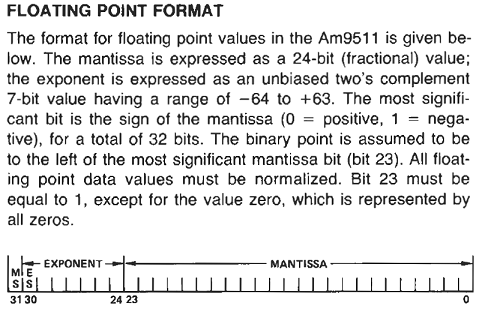Here are my last version looks like I run in to the "
egg or chicken dilemma" !
Putting a float in the source code of my OS / assembler / linker / compiler means I must convert it to a 4 byte value (dec or hex)
loop: I use log() and ^ (power of) to convert the float to binary and the Am9511 has this commands
but I need first the binary value of the float's to use log and power on the Am9511
goto loop :-(
I hope a genius can help and give me a stringToLong function
that will only parse the ASCII chars and build the 4 byte binary value of it (without val(),log() and "
^")
Without this more tricky function I have to write a cross compiler assembler at first.
Joshy
Code: Select all
' Am9511
const as ulong sign_mask = &B10000000000000000000000000000000
const as ulong expo_mask = &B01111111000000000000000000000000
const as ulong mant_mask = &B00000000111111111111111111111111
' PI in IEEE 754 format
dim as single PI = atn(1)*4
' PI in Am9511 binary format
const as ulong Am9511_PI = &H02C90FDA
const as ulong Am9511_5 = &H03A00000
' build text from a 4 byte Am9511 binary floating point number
function LongToString(byval value as ulong) as string
dim as single exponent = 2 ^ ((value and expo_mask) shr 24)
dim as single mantisse = value and mant_mask
dim as single bitval = 1.0
dim as integer bitpos = 2^23
dim as single mantissa
if (value and sign_mask) then exponent=-exponent
for i as integer = 1 to 24
bitval *=0.5
if (mantisse and bitpos) then mantissa += bitval
bitpos shr=1
next
return str(mantissa * exponent)
end function
' build a 4 byte Am9511 binary floating point number from text
function StringToLong(byval txt as string) as ulong
dim as single bitval
dim as integer exponent,bitpos,bits
dim as ulong result
dim as single mantissa,value=val(txt)
if value=0 then return result
' set sign bit and make value positive abs()
if value<0 then result =2^31 : value=-value
' get integer exponent and mantissa
exponent=int(log(value)/log(2))+1
mantissa=value / 2 ^ exponent
if exponent>0 then ' positive 7 bit loop
bitval = 128 : bitpos = 2^30 : bits = 7
else ' negative 6 bit loop
bitval = -64 : bitpos = 2^29 : bits = 6 : result or=2^30
end if
' build bits of the exponent
for i as integer=1 to bits
bitval /= 2
if exponent>=bitval then result or= bitpos : exponent -= bitval
bitpos shr= 1
next
' build bits of the mantissa
bitval = 1 : bitpos = 2^23 : bits = 24
for i as integer=1 to bits
bitval /= 2
if mantissa>=bitval then result or= bitpos : mantissa -= bitval
bitpos shr=1
next
return result
end function
print "single " & str(pi)
print "Am9511 " & LongToString(Am9511_PI)
print "Am9511" & LongToString(Am9511_PI or sign_mask)
var pi_binary = Stringtolong("3.1415926")
print "binary " & LongToString(pi_binary)
print
print "IEEE 754 " & bin(*cast(long ptr,@pi),32)
print "Am9511 " & bin(Am9511_PI,32)
print "PI " & bin(pi_binary,32)
print
print "IEEE 754 0x" & hex(*cast(long ptr,@pi),8)
print "Am9511 0x" & hex(Am9511_PI,8)
print "PI 0x" & hex(pi_binary,8)
sleep

